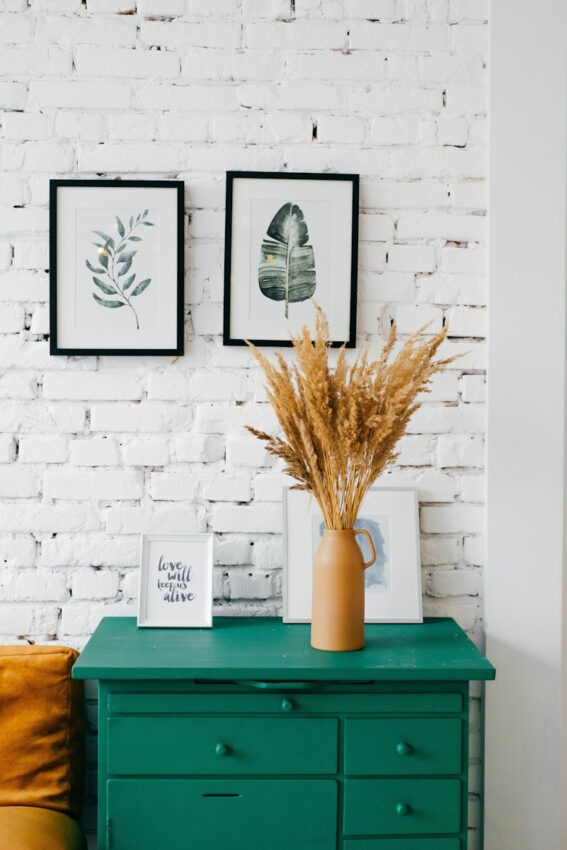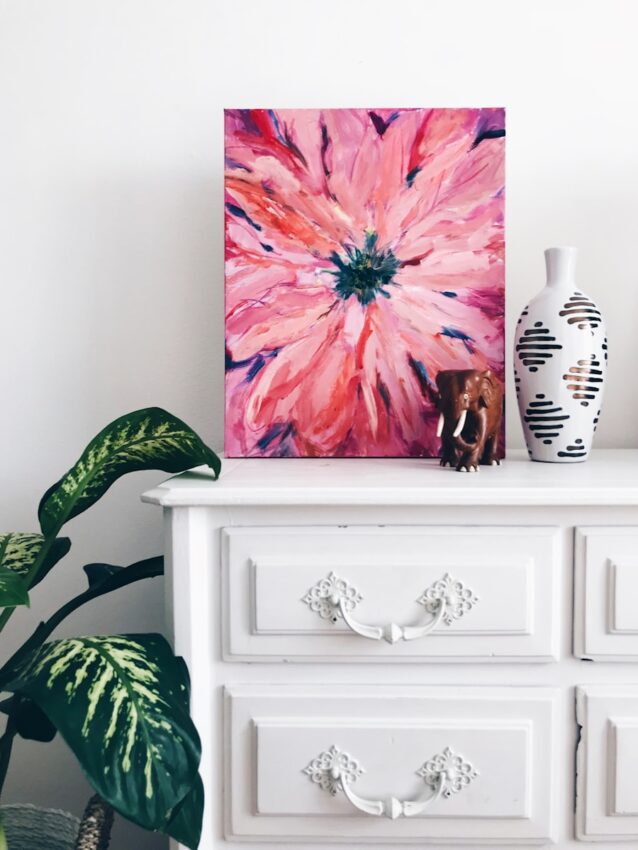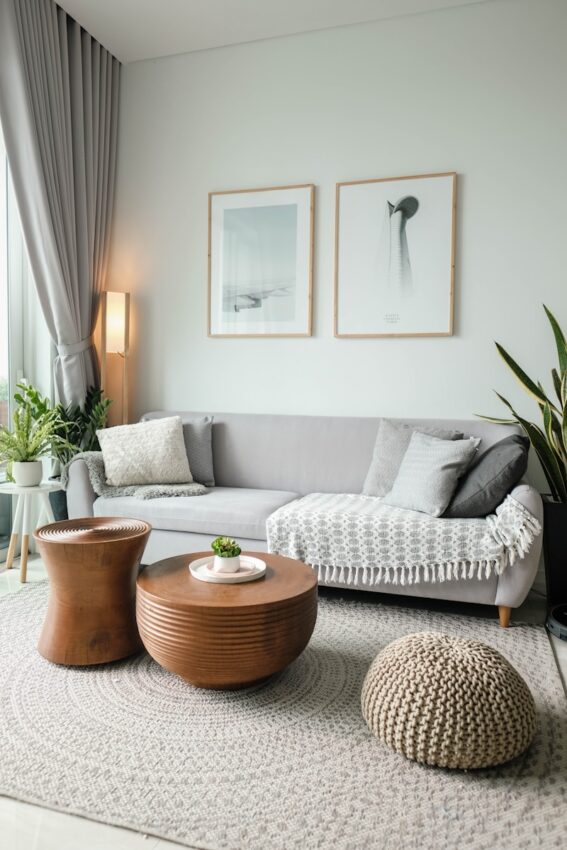Gallery walls have evolved beyond a simple decorating trend to become a design phenomenon in the last decade.
Art decoration can feel overwhelming for many people, yet the possibilities remain endless. The history stretches from salon-style arrangements of 17th-century Paris to today’s mixed-media displays. Art decoration has never been more exciting. My favorite aspect is art’s ability to create stunning focal points in minimalist spaces without competing with other decor elements.

Seven expert-approved ideas will help you become skilled at decorating with wall art in 2025. These tips will add personality to every corner of your home, whether you want to create a rotating gallery using picture ledges or bring art into unexpected spaces like bathrooms and kitchens.
Highlight a Focal Wall
A focal wall is one of the best ways I’ve found to decorate with art. It grabs attention right away when someone walks into a room.
Picking the right wall plays a vital role in making the biggest impact. The best choice usually catches your eye the moment you step into the room. On top of that, it could be the wall behind your bed, around a fireplace, or any architectural feature worth showing off.
Here are my top tips to create an influential focal wall:
- Choose a wall that naturally draws attention
- Think about the room’s architectural features
- Factor in natural lighting patterns
- Account for existing furniture placement
- Think about the room’s traffic flow
Large art pieces work really well as focal points in 2024. These showstoppers add sophistication to living spaces right away. Different frame options and mixing small and large-scale works can make the focal wall look fresh and dynamic.

Mix and Match Different Art Styles
I’ve found that blending different art styles creates the most captivating spaces in home decoration. Many homeowners feel unsure about mixing artistic elements.
The best way to start is with a unifying element that ties different pieces together. This could be a common color palette, shared theme, or consistent medium. A vibrant abstract painting pairs beautifully with black-and-white photographs when they share complementary hues.
Here’s my tried-and-tested approach to mixing art styles:
- Choose pieces with a connecting element (color, theme, or medium)
- Balance bold statement pieces with subdued works
- Mix different mediums like paintings, photographs, and textiles
- Include personal items that tell your story
Opt for Acrylic Paintings on Canvas
My years of interior design experience have shown that acrylic paintings on canvas are among the most adaptable art forms for home decoration. These pieces blend durability with visual appeal perfectly and work well in any space of your home. Whether you’re refreshing a living room or adding personality to a home office, you’ll find a wide range of acrylic paintings on canvas for sale that suit every style and preference.
Acrylic paintings truly stand out because they’re so versatile. You can use them in rooms with high humidity, like bathrooms and kitchens, without damaging their integrity. They resist scratches, fading, and water damage, which helps them stay beautiful for years.
Here’s what makes acrylic art great for decorating:
- Quick-drying properties allow for easy layering and modifications
- Water-based composition makes cleanup simple and safe
- Resistant to environmental factors
- Suitable for various surface textures and effects
Acrylic paintings give you exceptional flexibility with style and texture. They can mimic various painting techniques, from transparent watercolor-like washes to thick, textural applications. This adaptability lets you create different moods in your space.
These art pieces are great conversation starters. Their vibrant colors and unique textures naturally catch everyone’s eye, making them perfect for both statement pieces and subtle accents. You’ll find them valuable additions to any room’s design scheme.
Here’s what to look for when choosing acrylic paintings for your home:
- Room Environment
- Think about lighting conditions
- Check humidity levels
- Look at room temperature
- Design Integration
- Match existing color schemes
- Work with room dimensions
- Balance with other decor elements

Create a Gallery Wall
My experience shows that gallery walls are one of the most dynamic ways to decorate with art. Over the last several years, I’ve developed a simple approach that makes this intimidating task both manageable and fun.
Good planning prevents wall damage. You should measure your wall space and create a template on the floor with painter’s tape. This quick method lets you play around with different layouts before making any holes.
Mini-collections of 2-3 related pieces within the larger gallery wall guide viewers’ eyes across the display. This technique adds depth and tells a story through your art.
Current trends favor asymmetry and varied frame styles. This creates an authentic display that grows with your collection. Modern art mixed with vintage pieces adds personality to your space.
Three different frame finishes create the perfect balance. A wood tone, metallic finish, and neutral color like black or white offer enough variety while staying cohesive.
Incorporate 3D or Textured Art
Texture is a vital element in my approach to decorating with art. My design career has taught me how three-dimensional art pieces can change flat walls into visual experiences that appeal to both sight and touch.
Texture naturally finds its way into home décor. In fact, each material brings its own textural quality and creates layers of visual interest. Texture goes beyond physical touch – it creates visual weight and draws attention to specific areas of your space.
Light plays a significant role in enhancing 3D art, as I’ve seen in my projects. The right ambient lighting can change the whole space, making it feel soft or dramatically bold. This is why I always think about lighting placement before installing textured pieces.
Experiment with Fun and Creative Painting Kits
Painting kits have become an exciting way to create personal art for home decoration. My design consultations show more homeowners are using these fun and creative painting kits to add unique touches to their spaces.
Each kit includes everything you need to create satisfying artwork. Most projects take one to three hours, making them perfect for weekend creativity. These kits are a great way to start creating art, whatever your experience level.
My guide will help you pick the right painting kit:
- Skill Level Consideration
- Easy kits with larger spaces
- Advanced options with detailed patterns
- Custom difficulty levels
- Time Investment
- Quick projects (1-2 hours)
- Detailed works (2-3 hours)
- Multi-session projects
Custom options have changed how we approach DIY art. Personal paint-by-numbers sets turn cherished photos into paintable canvases. You can create meaningful pieces that tell your story through art. Benefits go beyond just creating something new. These kits help develop artistic skills, improve fine motor control, and teach patience. They work great for both solo creators and family time.
You’ll find many options – from landscapes and seascapes to seasonal décor and kid-friendly designs. This variety lets you create fresh pieces to rotate through your home’s display areas.
The sort of thing I love about these kits is how they make art available to everyone. You don’t need professional painting skills to create impressive results. Clear guidelines and step-by-step instructions make the process fun rather than daunting.
Your finished pieces can brighten up many areas in your home. Display your completed works in:
- Living spaces as conversation starters
- Personal spaces like bedrooms for meaningful connections
- Home offices for inspiration
- Children’s rooms to showcase accomplishments
Rotate Art Seasonally
Rotating art seasonally has become my favorite way to keep my home decor fresh and engaging year-round. My design career taught me that switching artwork with seasons creates a living space that mirrors nature’s patterns.
A designated feature wall works best to start your seasonal art rotation. You can create an ever-changing display that keeps your space fresh. Your home stays connected with the outside world and you build a deeper connection with changing seasons.
Nature-inspired collections work best for seasonal rotation. These pieces naturally match outdoor changes and make transitions feel organic. Rotating art lets you:
Create themed collections that reflect seasonal moods
- Spring: Floral prints and light landscapes
- Summer: Coastal scenes and abstract pieces
- Fall: Nature motifs and harvest themes
- Winter: Serene snowscapes and minimalist designs
Conclusion
Decorating your home with art is more than just an aesthetic choice—it’s an opportunity to express your personality and create a space that feels uniquely yours. From curating a striking focal wall to experimenting with fun and creative painting kits, these seven expert-approved ideas offer practical and inspiring ways to elevate your home decor in 2025.
Now’s the perfect time to embrace the versatility of art in your decor. Start small or go bold, but above all, make it your own. With these expert tips, your walls will transform from mere boundaries into a canvas for creativity and self-expression. Let your home become the gallery of your life.
